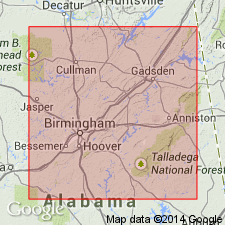
- Usage in publication:
-
- Cottingham Creek Member*
- Modifications:
-
- Named
- Dominant lithology:
-
- Dolomite
- Conglomerate
- AAPG geologic province:
-
- Appalachian basin
Summary:
Named Cottingham Creek Member of Lenoir Limestone. Occupies a paleotopographic low (karst feature) in Newala Limestone of Early Ordovician age. Lowest unit in Lenoir Limestone at type section. "The base of the member consists of recrystallized conglomeratic dolostone containing pebbles, cobbles, and boulders of lime mudstone, packstone/grainstone, and dolomudstone. The clasts are as much as 30 cm in diameter and all appear to have been derived from the Newala Limestone. The basal conglomerate is overlain by various types of dolostone, including dark-brown, bryozoan-rich dolowackstone and dolomudstone, burrowed dolomudstone, and greenish-gray dolosiltite. Cross-bedding is well developed updip and at the base of the unit. The uppermost part of the member is a thick-bedded, massive, sandy, argillaceous, brownish-gray dolostone that is laterally continuous across the depression." Megafossils are predominantly bryozoans but include brachiopods and gastropods. Maximum thickness uncertain because base of paleotopographic low extends beneath the Cabaha River. Estimated to be 16 m. Probably correlates with the Douglas Lake Member of Lenoir Limestone in Tennessee. Overlies Newala Limestone; underlies Mosheim Member of Lenoir Limestone. Age is Middle Ordovician (middle to late Whiterockian).
Source: GNU records (USGS DDS-6; Reston GNULEX).
For more information, please contact Nancy Stamm, Geologic Names Committee Secretary.
Asterisk (*) indicates published by U.S. Geological Survey authors.
"No current usage" (†) implies that a name has been abandoned or has fallen into disuse. Former usage and, if known, replacement name given in parentheses ( ).
Slash (/) indicates name conflicts with nomenclatural guidelines (CSN, 1933; ACSN, 1961, 1970; NACSN, 1983, 2005, 2021). May be explained within brackets ([ ]).

